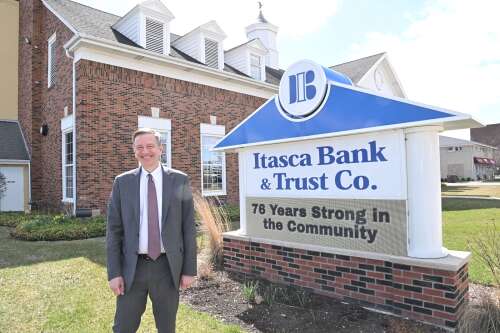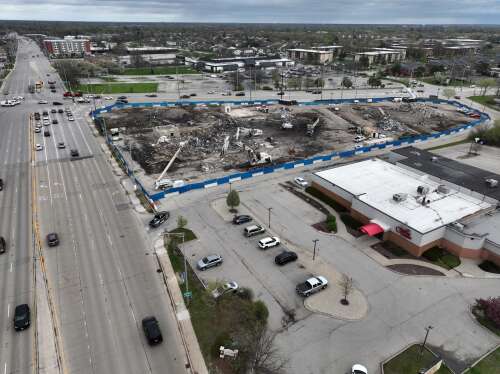The secret to their survival is a long-standing local presence, personal relationships with customers and specific loan niches, all while keeping up with technology, say suburban community bankers.
Community banks are locally owned and operated and are the primary driver of small business loans, agricultural loans and commercial loans, said Ron Haynie, senior vice president of mortgage finance policy for the national association Independent Community Bankers of America.
“Small town America and rural America is generally where you’re going to have community banks, but we are in every big market and every suburban area,” he said. “Community banking is for everybody. There is no special clientele, really.”
The Federal Reserve defines community banks as having under $10 billion in assets, and regional banks as having $10 billion to $100 billion in assets. Banks exceeding $100 billion are considered large financial institutions, with JPMorgan Chase, Bank of America and Wells Fargo leading the pack.
Illinois had 424 community banks in May, the second-largest for any state after Texas, according to ICBA data. Some banks bill themselves as community banks when their assets are much larger than actual community banks, Mensching pointed out.
Altogether, there were 4,140 community banks insured by the FDIC nationwide at the end of 2023, down 26 from the previous quarter, according to FDIC data. Twenty banks merged, several transitioned from community to non-community banks or vice versa, one opened and one failed.
Both community and non-community banks steadily have declined in numbers since 2009, with mergers causing the majority of the drop in community banks, according to FDIC data.
Community banks’ specialty is developing relationships with customers, Haynie said.
“Can customers transact business online? Absolutely. Community banks provide all the technology … all the modern banking and electronic banking. They provide all the services, but the key is that it’s personal,” he said. “Customers can sit down and talk to the banker about whatever they want to do. It goes beyond any one particular type of loan. It’s having a relationship with a particular customer for all their needs.”
A part of the community
Community banks focus on being active locally, said Jim Mensching, president of Itasca Bank & Trust in Itasca.
For example, on the occasion of its 75th anniversary last year, Itasca Bank & Trust launched a campaign to combat local food insecurity with food drives and monetary donations.
“We can’t outbranch larger banks. We can’t outsize them,” he said. “What we can do is be part of our community.”
Itasca Bank & Trust, which takes pride in having a person answering phones rather than having an automated attendant, was started by Mensching’s grandfather and great-grandfather. It is owned by about 260 local shareholders, many second- and third-generation, Mensching said.
Customers can greatly benefit from having a relationship with their local banker, said Greg Ohlendorf, president and CEO of First Community Bank and Trust, a 108-year-old bank with branches in south suburban Beecher and Peotone.
“We are all capitalists, and we all want to make money,” he said. “But at the end of the day, if you have a problem and at your institution the only person you know is the teller you deposit your checks to, that’s a problem. With my customers, they can call me and I can make decisions that the front-line employees can’t.”
Community banks also have more flexibility, such as often being able to provide loans to customers who’ve been rejected by larger banks, the bankers said.
“We are in our customers’ businesses so we can see what they are doing on a one-to-one basis,” Ohlendorf said. “We don’t have a rigid black box mode that puts people in or not. We are going to work with the customers and try to make the loan.”
Online banking trend
Keeping up with technological advances is imperative to the success of any community bank, and the COVID-19 pandemic gave everyone a further push in that direction, the bankers said.
“The pandemic made the adoption of online banking, which had been growing over time, shoot up through the roof when people didn’t want to leave their house,” Mensching said.
First Community Bank has taken pride in implementing technological advances since the late 1980s, and now is navigating the latest financial technology, or “fin tech,” revolution in community banking that started about six years ago, Ohlendorf said.
“It’s a really fun time to do new things again,” said Ohlendorf, who’s worked at First Community Bank for nearly 40 years. “There are a lot of start-up companies that help community banks deliver new products and services to their customers as well as help banks run more efficiently.”
For example, the bank is working on being able to allow customers to apply for an unsecured consumer loan of up to $25,000 or so on their mobile devices, he said.
The ICBA recently launched a Center for Innovation in Atlanta, Georgia, with the goal of fostering partnerships between community banks and “fintech” service providers.
Post-pandemic high office vacancy rates aren’t affecting the community banking industry, the bankers said, because community banks typically issue owner-occupied commercial real estate loans.
“Community bankers aren’t financing office towers,” Haynie said. “The kind of commercial real estate loans they do are local office parks, medical-related and local businesses. We just had an annual convention and in talking to members — we had 1,000 bankers — I didn’t hear any of them saying they are concerned about their commercial real estate portfolio.”
Also, small business owners typically are personally and staunchly invested in their businesses, Ohlendorf said. “The business is who they are as a human being, and they are going to do everything they can to save their business and keep their employees.”
In for the long haul
A current trend is credit unions buying small community banks, Mensching said.
GreenState Credit Unit based in Iowa, for example, acquired Oak Brook-based Oxford Bank and Trust in 2022.
Credit unions are exempt from paying corporate income tax, typically pay higher interest rates on savings accounts and CDs, and might offer more competitive loan rates, Mensching said.
“That’s a pressure on us, for sure,” he said.
Banking is among the most regulated businesses in the United States, and last year’s collapse of Silicon Valley Bank, which had about $208 billion in assets, prompted increased scrutiny, Haynie said.
“I am not going to say community banks don’t make bad decisions once in a while. They do. But for the most part, community bank loans tend to perform better than the loans made by the bigger banks.”
Community banks typically are well-diversified, which minimizes their risk level, added ICBA Vice President of Communications Nicole Swann.
Provided they survive pending legal challenges, banks will have to navigate new Consumer Financial Protection Bureau regulations for small business loan data collection and reporting, Haynie said.
That will be especially challenging for community banks because, by nature, small businesses loans are not standardized, he said.
By and large, community banks are well-capitalized and run fairly conservatively, which in turn ensures longevity, Haynie said.
“A lot of us are 100 years old. I’ve got friends who are approaching their 150th anniversary,” Ohlendorf agreed. “I mean, that’s saying something.”
President Jim Mensching walks among the safety deposit boxes at Itasca Bank & Trust on Irving Park Road in Itasca. He says many banks no longer have these boxes but customers appreciate them.
John Starks/jstarks@dailyherald.com
Teller Marta Kopacz at Itasca Bank & Trust on Irving Park Road in Itasca. The bank has been operating for more than 75 years.
John Starks/jstarks@dailyherald.com







